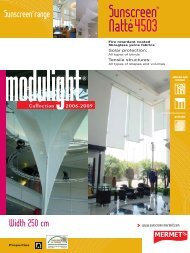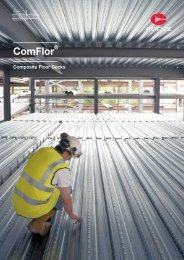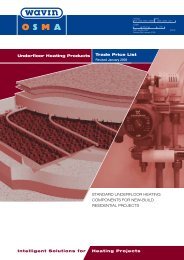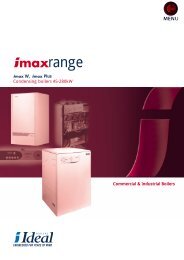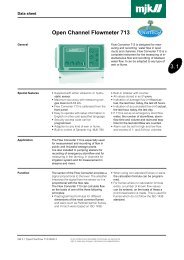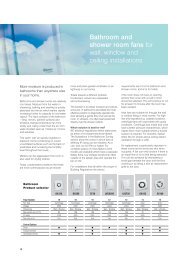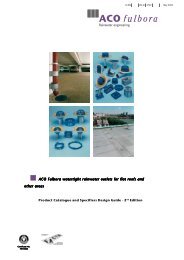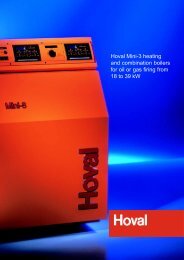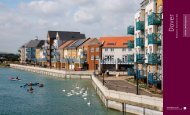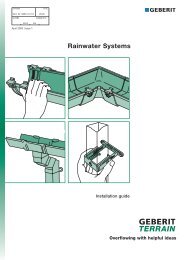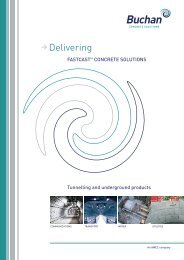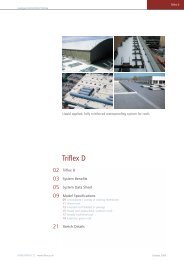Create successful ePaper yourself
Turn your PDF publications into a flip-book with our unique Google optimized e-Paper software.
218<br />
FIRE PROTECTION<br />
INTRODUCTION<br />
Contents<br />
Performance tables 219<br />
Cormet Shaftwall<br />
Cormet Column and Beam<br />
227<br />
Clip System 237<br />
What Can Go Wrong Checklist 246<br />
<strong>Fire</strong> protection from<br />
Lafarge<br />
When deciding on appropriate<br />
methods of fire protection, the<br />
specifier needs to be absolutely sure<br />
that the systems selected are both<br />
reliable and totally effective. These<br />
are the most important design<br />
considerations, as lives and<br />
livelihoods are at stake, and it is<br />
imperative to make the right<br />
decisions. Not only are Lafarge<br />
Cormet fire protection systems<br />
reliable and effective, they are more<br />
economic and practical to install onsite<br />
than alternative constructions.<br />
Lafarge offer a full range of passive<br />
fire protection products, from<br />
compartment walls to special<br />
systems for encasing beams and<br />
enclosing shafts. Lafarge systems<br />
have been exhaustively tested by<br />
independent test houses, tried and<br />
refined over many years to satisfy a<br />
range of regulatory standards.<br />
<strong>Fire</strong> testing<br />
All Lafarge Plasterboard systems are<br />
tested at one of the following:<br />
• Building Research Establishment<br />
• Timber Research and<br />
Development Association<br />
• Warrington <strong>Fire</strong> Research<br />
• Aycliffe <strong>Fire</strong> Testing Facility<br />
This means that installers and<br />
specifiers can be absolutely sure that<br />
Lafarge Cormet fire protection<br />
systems are tested in accordance<br />
with BS 476: Part 21: 1987 or<br />
BS 476: Part 22: 1987 as appropriate<br />
by the UK’s leading independent<br />
accredited test houses, so there is a<br />
100% guarantee that systems work,<br />
when installed to Lafarge<br />
specification.<br />
Details on Lafarge Plasterboard Steel<br />
<strong>Protection</strong> systems are also listed in<br />
the ASFP (Association for Specialist<br />
<strong>Fire</strong> <strong>Protection</strong>) Yellow Book.<br />
NB: The data shown in the tables under fire<br />
resistance has been tested to<br />
BS 476: Part 21: 1987 (Beams and Columns),<br />
BS 476: Part 22: 1987 (Shaft Walls)<br />
Cormet Shaftwall<br />
Cormet Shaftwall is a fire protection<br />
system providing up to 120 minutes<br />
fire resistance for shafts in multistorey<br />
buildings, including lift shafts,<br />
stairwells, service ducts and plant<br />
rooms.<br />
It is erected from one side only. This<br />
feature also makes it ideally suited<br />
for lining and dividing large<br />
industrial or warehouse spaces and<br />
meeting Building Regulations fire<br />
resistance requirements where such<br />
premises are within 1 metre of an<br />
adjacent property.<br />
Cormet Shaftwall is light in<br />
construction and is ideal for fast<br />
track construction programmes.<br />
Cormet Column and Beam Clip<br />
System<br />
In a fire, unprotected structural steel<br />
begins to lose its strength at<br />
temperatures above 550ºC. Selection<br />
of a suitable encasement system is<br />
essential. The factors which affect<br />
this selection are:<br />
• the period of fire protection<br />
required<br />
• the physical properties (size and<br />
mass) of the steel section<br />
• the application – column or beam<br />
and the number of exposed faces,<br />
2, 3 or 4.<br />
The degree of fire protection<br />
required for a steel section has been<br />
shown to depend on its Hp/A factor,<br />
which is a function of the heated<br />
perimeter of the section related to<br />
its cross sectional area. A section<br />
with a high Hp/A factor will heat up<br />
more rapidly than one with a low<br />
Hp/A factor, and so may require a<br />
higher specification of encasement<br />
to achieve the same level of fire<br />
protection.<br />
TECHNICAL ENQUIRYLINE t 01275 377789 f 01275 377456 www.lafargeplasterboard.co.uk<br />
To select the optimum encasement<br />
solution:<br />
1. Identify the period of protection<br />
required.<br />
2. Confirm the number of sides to<br />
be protected.<br />
3. If the protection factor of the<br />
column, beam or joist is not<br />
known, consult tables 5.6 to 5.8<br />
to identify the Hp/A.<br />
4. Decide on the appropriate<br />
Cormet fire protection system,<br />
details of which are given in this<br />
section, tables 5.1 to 5.5 and 5.9.<br />
5. Choose thickness of materials<br />
from Hp/A tables for each<br />
Lafarge system<br />
6. Design details.



